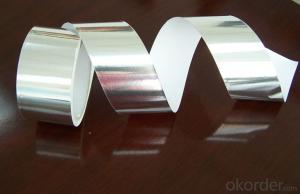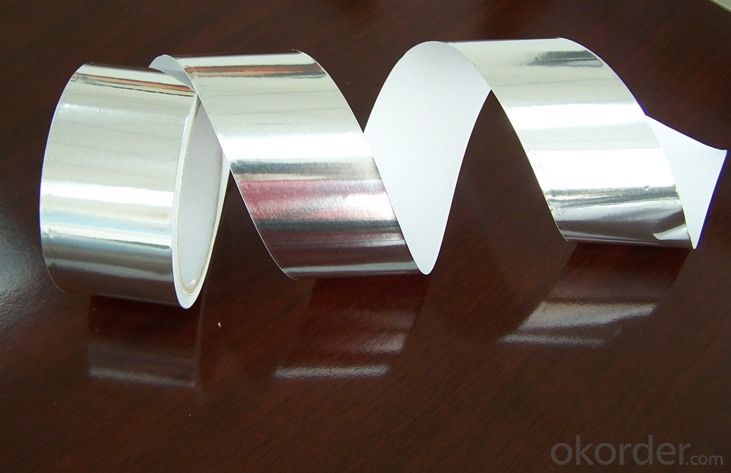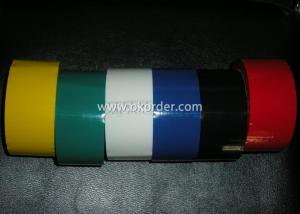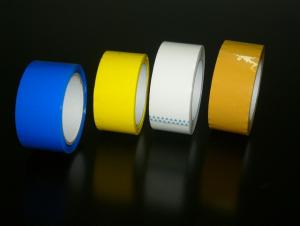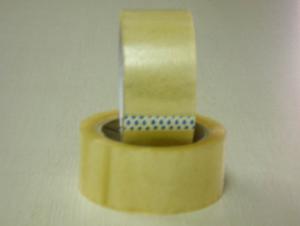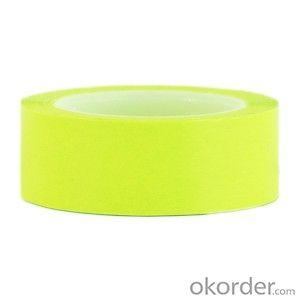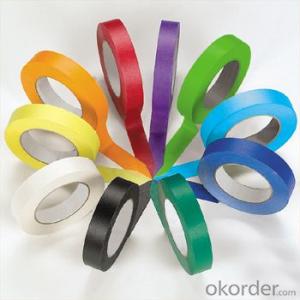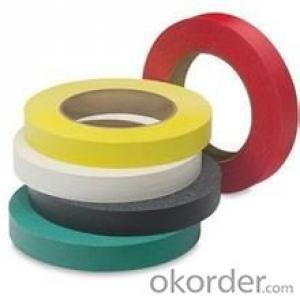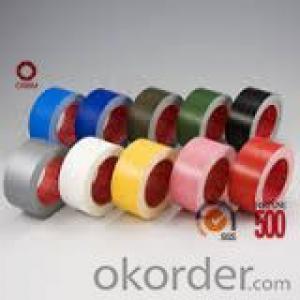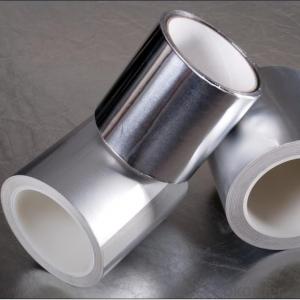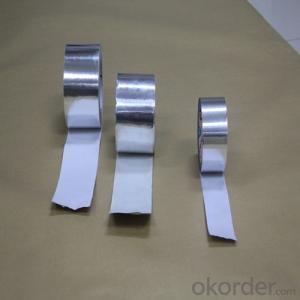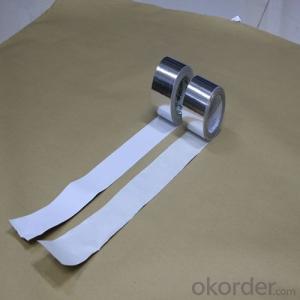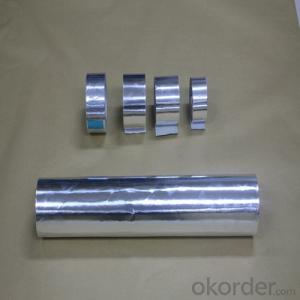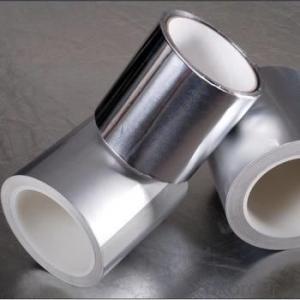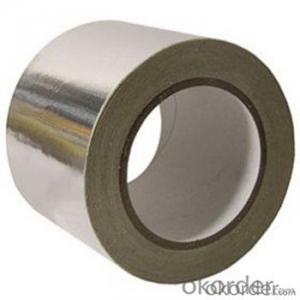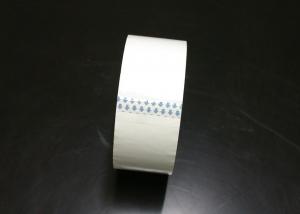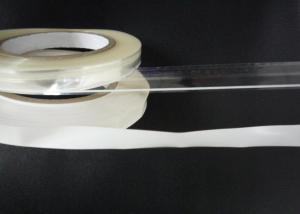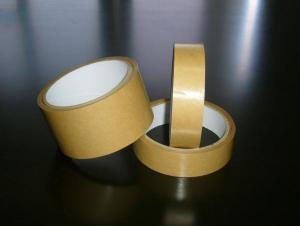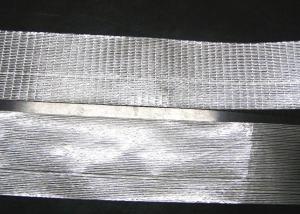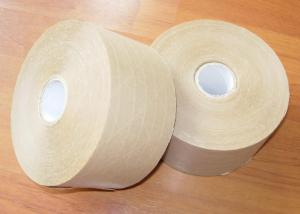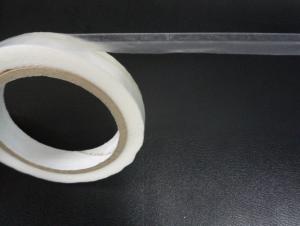Re-sealable Food Packaging Tape - Solvent Based Acrylic Aluminum Foil Tape T-S3601P
- Loading Port:
- Shanghai
- Payment Terms:
- TT OR LC
- Min Order Qty:
- 3000 roll
- Supply Capability:
- 1000000 roll/month
OKorder Service Pledge
OKorder Financial Service
You Might Also Like
Solvent based acrylic aluminum foil tape
Construction: 36 micron Aluminum Foil plus high performance solvent acrylic adhesive plus easy-release silicone release paper
Carrier: Aluminum Foil
Adhesive: solvent based acrylic
Foil thickness: 36 micron
Adhesion to steel: 20N/25mm
Tensile strength: 50N/25mm
Elongation: 3.0%
Service temperatures: -20~80 DC
Typical applications: HVAC industry for joining and sealing foil-scrim-kraft facing laminated fiberglass blanket/duct board joints and seams; joining and sealing flexible air duct seams and connections. May also be used for other industrial uses requiring a tape with these characteristics and benefits.
Jumbo size: 1.2m x 1200m
Log roll: 1.2m x 45m/50m/100m
Cut roll: As customer required
Shelf time: 12 months
Company information
CNBM International Corporation (CNBM International) is the most important trading platform of CNBM Group Corporation, a state-owned company under the direct supervision of State-owned Assets Supervision and Administration Commission of the State Council.In line with the business, CNBM International launched E-business platform Okorder.com.CNBM International is highly recognized by its business partners and clients all over the world and has obtained rapid development under the spirit of win-win. We will carry on the mutual beneficial, innovative and revolutionary trading structure as we did before, create value for our employees, share holders and clients and benefit the whole society in our future developmen.
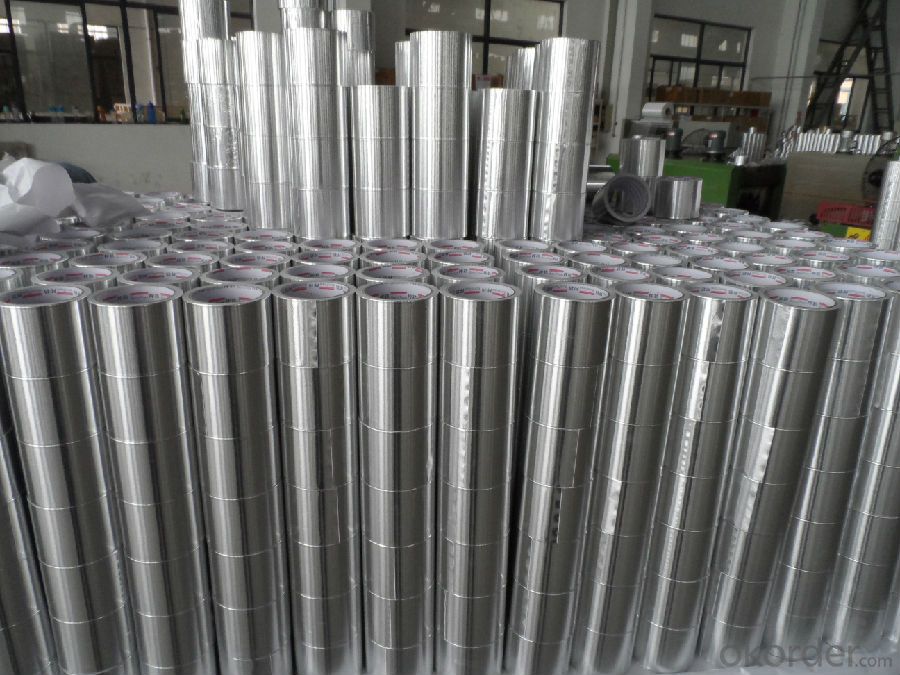

- Q: What are the considerations for using packaging tape on painted surfaces?
- When considering using packaging tape on painted surfaces, there are several important considerations to keep in mind. Firstly, it is crucial to assess the type and condition of the paint on the surface. If the paint is old, flaking, or in poor condition, using packaging tape may cause further damage such as peeling or chipping off the paint. In such cases, it is advisable to avoid using tape directly on the painted surface. Another important consideration is the adhesive strength of the packaging tape. Some tapes have strong adhesives that may stick firmly to the painted surface, making it difficult to remove without damaging the paint. It is recommended to test a small, inconspicuous area with the tape to ensure it can be safely removed without leaving residue or causing any harm. Furthermore, it is crucial to consider the duration for which the tape will be applied. If the tape is intended to be left on the painted surface for an extended period, there is a higher risk of it causing damage. Over time, the adhesive may bond more strongly with the paint, making it harder to remove without causing any harm. Additionally, the surface texture plays a role in determining the suitability of using packaging tape. Rough or uneven surfaces may not allow the tape to adhere properly, leading to lifting or peeling, which can damage the paint. Lastly, it is essential to consider the purpose of using packaging tape on the painted surface. If the objective is to protect the paint from scratches or damage during transportation or storage, alternative methods such as using protective sheets or bubble wrap may be more suitable and less likely to harm the paint. In conclusion, when considering using packaging tape on painted surfaces, one must assess the type and condition of the paint, adhesive strength, duration of application, surface texture, and the purpose of using the tape. By taking these considerations into account, one can ensure that the tape is used safely without causing any damage to the painted surface.
- Q: How do I prevent packaging tape from tearing during removal?
- To prevent packaging tape from tearing during removal, you can try gently heating the tape with a hairdryer to soften the adhesive. This will make it easier to peel off without tearing. Additionally, you can use a knife or a razor blade to carefully cut along the edges of the tape before peeling it off.
- Q: Can packaging tape be used for sealing packages with heavy items?
- Certainly, one can utilize packaging tape to seal packages that contain bulky items. Packaging tape is purposely crafted to offer robust stickiness and sturdiness, thus rendering it ideal for securing packages that carry weighty contents. It is manufactured from resilient materials such as polypropylene or acrylic, guaranteeing its ability to endure the weight and pressure of substantial items without tearing or becoming loose with ease. Furthermore, packaging tape frequently possesses a formidable adhesive backing that adheres well to different surfaces, thus ensuring a reliable seal. Nonetheless, it is imperative to select the fitting width and thickness of packaging tape in order to ensure proper sealing for packages with heavy contents.
- Q: Can packaging tape be used for sealing plastic bags?
- Indeed, sealing plastic bags can be accomplished with the utilization of packaging tape. Designed with robust adhesive properties, packaging tape can effectively secure various items, including plastic bags. To achieve a secure seal and prevent spillage or exposure to air and moisture, the tape can be applied either along the opening or across the entire width of the bag. It is worth mentioning, though, that while packaging tape can serve the purpose, it may not be as efficient as specialized plastic bag sealing techniques like heat sealing or ziplock closures, which are specifically engineered for this particular task.
- Q: What course of packing and cartons do we use for our company?
- The cartons and tapes used by the company are packed into the raw material subjects.
- Q: Does packaging tape come in different lengths?
- Yes, packaging tape does come in different lengths. Packaging tape is available in various lengths to accommodate different packaging needs. Common lengths for packaging tape include 55 yards, 110 yards, and 1000 yards, although other lengths may be available as well. The length of the packaging tape you choose depends on the size and quantity of packages you plan to seal. It is important to consider the length of packaging tape needed to ensure you have enough to securely seal your packages without running out.
- Q: Can packaging tape be used for sealing furniture or home goods?
- Packaging tape can indeed be utilized to seal furniture or home goods. Its design aims at delivering a secure and robust seal, rendering it apt for diverse applications like sealing boxes and packages. By employing packaging tape on furniture or home goods, one can effectively safeguard the item during transportation or storage. It is crucial to ensure the tape's proper application, avoiding any surface damage or residue. Furthermore, depending on the item's weight and size, it may be advisable to employ specialized tapes or techniques specifically tailored for sealing furniture or home goods, ensuring optimal protection.
- Q: Is packaging tape safe to use on plastic cutting mats?
- Packaging tape is generally safe to use on plastic cutting mats, but it is important to consider a few factors before using it. Firstly, ensure that the plastic cutting mat is made of a durable and food-safe material. Some low-quality plastic cutting mats may be prone to scratching or tearing when adhesive tape is applied, so it is advisable to check the manufacturer's recommendations or guidelines. Secondly, consider the purpose of using packaging tape on the cutting mat. If it is for temporary storage or transportation, packaging tape can be suitable as it provides a secure seal. However, if the tape will be in direct contact with food or used during food preparation, it is recommended to avoid using packaging tape. Adhesive residues from the tape may transfer onto the food or contaminate the cutting surface, which could pose a health risk. In such cases, it is better to use food-grade or specialized tape that is specifically designed for use with cutting mats or food preparation surfaces. In conclusion, while packaging tape can be safe to use on plastic cutting mats, it is crucial to consider the quality of the cutting mat, the purpose of using the tape, and potential food safety concerns. Always prioritize the safety and hygiene of your food preparation surfaces when choosing the appropriate tape.
- Q: Is packaging tape resistant to extreme pressure or weight?
- Yes, packaging tape is designed to be resistant to extreme pressure or weight. It is specifically made to securely hold and seal packages, ensuring they stay intact even when subjected to heavy loads or pressure.
- Q: Is packaging tape easy to remove without damaging surfaces?
- Packaging tape is generally designed to be easily removable without causing damage to surfaces. However, the ease of removal can vary depending on several factors such as the type and quality of the tape, the surface it is applied to, and the length of time it has been in place. Most packaging tapes are designed to adhere firmly to surfaces during transit or storage, ensuring that the package remains sealed and secure. However, they are also designed to be peeled off easily when needed, without leaving behind residue or causing damage. In most cases, packaging tape can be removed by simply peeling it off slowly and evenly. The adhesive used in packaging tapes is typically formulated to have a good balance between adhesion and removability. This allows for easy removal without requiring excessive force or leaving behind sticky residue. However, there can be instances where the tape may be more difficult to remove, especially if it has been in place for an extended period or exposed to extreme temperature conditions. In such cases, it may be helpful to use heat (such as a hairdryer) to soften the adhesive, making it easier to peel off. It is worth noting that the ease of tape removal can also depend on the surface it is applied to. Smooth, non-porous surfaces like glass or metal are generally easier to clean without any damage. On the other hand, porous or delicate surfaces like wood or painted walls may require more caution and care during removal to avoid any potential damage. In conclusion, while packaging tape is generally easy to remove without damaging surfaces, it is important to consider factors such as tape quality, surface type, and removal technique to ensure a smooth and damage-free removal process.
Send your message to us
Re-sealable Food Packaging Tape - Solvent Based Acrylic Aluminum Foil Tape T-S3601P
- Loading Port:
- Shanghai
- Payment Terms:
- TT OR LC
- Min Order Qty:
- 3000 roll
- Supply Capability:
- 1000000 roll/month
OKorder Service Pledge
OKorder Financial Service
Similar products
Hot products
Hot Searches
Related keywords
